Photo: Belmont Town Meeting
And welcome to the first night of the 2017 annual Belmont Town Meeting being held in the Belmont High School auditorium, Monday, on May Day.
I have been told by Town Clerk Ellen Cushman that tonight’s meeting will attempt to vote on the first six articles in the warrant. That will include setting a standard 25 mph speed limit throughout town (article 3), revamp the Demolition Delay Bylaw (Article 4), update and codify a “signs” bylaw (Article 5) and accepting a temporary moratorium on the establishment of retail marijuana stores in town (article 6).
7:05 p.m.: Town Moderator Mike Widmer calls the meeting to order. The invocation is read by Pastor Cheryl Minor of All Saints Church.Boy Scouts Troops 304 and 377 along with Girl Scouts from Troops 62578, 79207, 85470 and 72490 present the flag while Girl Scouty Clarice O’Neil, a Butler 2nd grader, leads the meeting in the Pledge of Allegiance. The national anthem is sung by the Belmont High School senior A Capella.
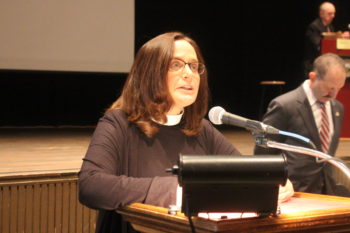
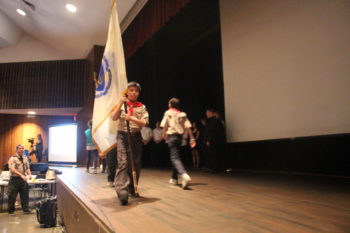

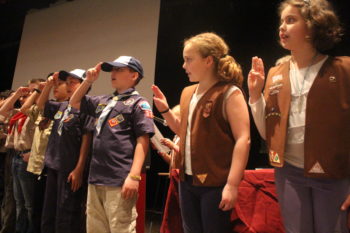
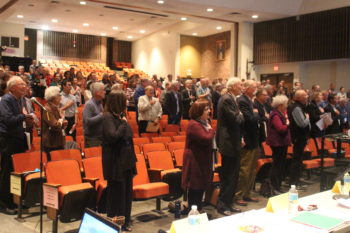
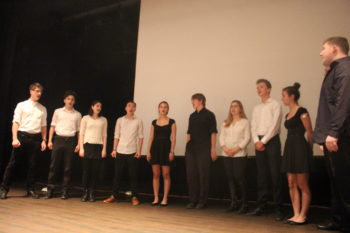
7:22 p.m.: The new and re-elected town meeting members are sworn in by Town Clerk Cushman.
The Town Meeting honors the long-serving members. Mark D’Andrea (44 years) gives some practical advice to Town Meeting: Speak up when you come to the microphone.
7:28 p.m. A wonderful appreciation of Ruth Kaplan, who died at 98 in February.
7:30 p.m.: Town Moderator Mike Widmer said that there is “significant confusion” about the difference between an article and the motion. He also spoke about “scope” of an article under debate. It will be important when getting to articles such as pay as you throw and the Welcoming Town amendment. It will not be a debate about the Trump administration and its policies or be making any conjecture on the impact on the town’s finances by passing the article, he said.
7:40 p.m.: And we are underway: Article 3 which is the speed limit article. Should Belmont reduce the “statutory speed limit” in thickly settled areas (basically all but three stretches or road in Belmont) or where there are special speed regulation; about 12 streets such as Goden, Lexington, School, and Clifton, to 25 mph.
Discussion: (lots of members already in line on this one) Joel Semuels, Pct. 6, worries that a minor traffic ticket could cause a $200 surcharge for six years on their insurance. Glenn Clancy, director of Office of Community Development, basically admits that the police has a great deal of “discretion” on giving tickets, admitting that if you are going just a bit over the speed limit, it’s unlikely you’ll be getting a ticket.
Bob McLaughlin, Pct. 2, (a proud owner of a Porsche) said he wished he could travel faster than second gear. He said he didn’t believe raising five mph isn’t that much safer. “What governs best, governs least.”
Rachel Berger, Pct. 2, while supporting the amendment, believes that it is enforcement not speed limit that will make roads safer.
Sue Bass, Pct. 3, agrees that it’s is enforcement that is important, especially signs that tell the speed limit. She would also like to see more raised crosswalks.
Clancy said many communities are taking action in reducing speed limits which he believes will “recondition” how drivers throughout the region to drive at lower speeds, and if it takes ten years, will make roads safer.
Brooke McKenna, Pct 5, said lowering the speed limit may “not be a perfect solution,” – there could be more enforcement – but it is the first step towards safer roads. Slower speeds would result in higher survivability rates to victims of car accidents
Paul Roberts, Pct. 8, said the way roads are used have changed – more bikes and pedestrians sharing the road – and smartphones putting more cut-through traffic onto local roads. “Don’t make the perfect the enemy of the good.”
Corinne Olmsted. Pct. 1, also brings up the issue of cut-through traffic that is sent through Belmont via traffic-avoidance software. Reducing the speed limit could make the town less attractive to those drivers.
Jack Weis, Pct. 1, said he’s opposing the amendment because it’s a “one size fits all” solution which doesn’t work on the major “commuter” roads that crisscross the town. If drivers don’t believe the speed is “practical” they will see how much above the limit they can go.
The question has been moved! One hour of debate. Whew!
And for some reason the vote was not registered, which had one member quip, “It’s the Russians.”
So we go to a voice vote. It’s almost quaint to hear the yeas and nays. And the ayes have it. The speed limit in Belmont will soon be 25 mph with a few exceptions.
Next up, the Demolition Delay Bylaw amendment. Widmer reminds anyone who has a financial interest in a property impacted by the bylaw must mention it.
The bylaw, which originally passed in 2013, is being renewed due to a sunset clause. It only applies to a limit number (182) of specific buildings, there is an appeals process, and it does not prevent demolitions, said Lauren Meier, the co-chair of the Historic District Commission. The most significant change is increasing the term of the delay from 6 to 12 months. “It’s not an undue financial burden,” Meier said.
You can read about the 2017 bylaw here.The Board of Selectmen and the Planning Board gave unanimous support to the renewal of the bylaw.
Some real opposition to the amendment by several members – many who opposed the bylaw in 2013 – who are aspirated by increasing to 12 months the delay.
The complains includes a restraint of private property rights, using the bylaw as a “lever” against a homeowner, there is a financial penalty on the property and, really, if some developer wants to tear down a historic building, he’ll just thumb their nose at the town, six months vs. 12 months. Meier said the bylaw isn’t perfect but it does give public notice and provides the community a way to have a voice on these issues. Good give and take on an issue that effects only two percent of the housing stock.
The motion called and here is the vote: 183 to 72 in favor – the bylaw passes.
9:55 p.m.: Now the “signs” amendment, sponsored by the Planning Board. Barbara Fiacco, vice chair of the Planning Board, presents the amendments briefly to the old bylaw which are 30 years old. Standing signs would be reduced to being no more than five feet high; window signs would be reduced from 50 percent to 20 percent of the total window area; there was no regulations and awnings and sandwich board sign; temporary signs will be reduced for 60 days; flashing signs and string of lights would be prohibited and you will have to maintain your sign. Non-commercial signs would be allowed in all zoning areas just to keep in within a recent Supreme Court ruling. What’s non-commercial? Schools, non-profits, religious
Small business owners and some members feel some of the restrictions – strings of lights, a sign saying “Drive slow” – are nitpicking. What about those commercial signs for landscaping firms in the strip of land between the sidewalk and the street – known as the town’s right of way? It now has to be removed after 90 days or after the work is done, whatever is shorter.
Vince Stanton, Pct. 3, then Bob McGaw, Pct. 1 and later Jack Weis, Pct. 1, were acting as copyeditors to the article, changing the wording for clarity.
What about the farmers market? The smaller ones in people’s yards have to be taken away after 90 days (it’s currently 100 days).
Finally the questions end and the vote takes place. And it’s a big “Yes” margin, 186 – 46.
The meeting is now adjourned until Wednesday, May 3.








Leave a Review or Comment